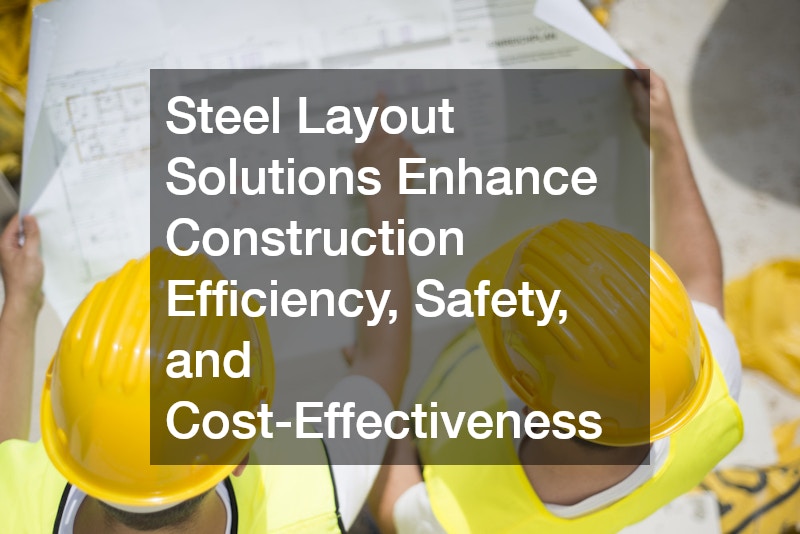
The integration of advanced steel layout solutions has revolutionized construction projects, offering precision, efficiency, and cost-effectiveness. This article delves into how these solutions impact various aspects of construction, addressing common queries and concerns.
1. What Are Steel Layout Solutions?
1.1 Definition and Components
Steel layout solutions encompass a range of technological tools and software used to design, plan, and execute steel structures in construction projects. These solutions integrate sophisticated modeling software with on-site hardware to ensure accurate implementation of structural designs.
By combining digital and physical resources, these solutions help bridge the gap between project conception and physical reality. This technology enables construction engineers to control every aspect of steel fabrication and assembly with unprecedented detail.
Various components, such as laser-guided tools and mapping software, work together within these systems to ensure optimal accuracy. Each component serves a specific function, ensuring that the final structural layout precisely matches the initial designs.
1.2 Key Benefits
Explore the primary advantages of steel layout solutions, including enhanced precision, reduced material waste, and increased productivity. These tools offer a greater level of detail and accuracy in planning, significantly reducing errors and alterations during construction.
With improved precision, the use of steel layout solutions results in less wasted material, driving down costs and promoting sustainable practices. The integration of advanced technology in layouts allows for better resource allocation and smarter project management.
Furthermore, increased productivity is achieved due to optimized workflows and enhanced design processes. Construction teams are able to execute their tasks more efficiently, thanks to the streamlined nature of these solutions.
2. How Do Steel Layout Solutions Enhance Project Efficiency?
2.1 Streamlining Planning and Design
Discuss how steel layout solutions facilitate efficient planning and design processes, reducing time and improving accuracy. Precision in the early stages of a project leads to smoother execution and fewer uncertainties later on.
The use of digital models and simulations allows for early detection of potential design flaws, eliminating unnecessary revisions. By addressing issues prior to physical construction, projects face fewer delays and achieve completion quickly.
Efficient planning through steel layout solutions minimizes the risk of costly setbacks, ensuring a project stays on track. Through advanced orchestration of construction demands, these tools allow for a seamless flow of operations.
2.2 Automation and Workflow Optimization
Examine the role of automation in optimizing construction workflows through the use of these solutions, leading to faster project completion. Automated processes reduce the need for manual intervention, allowing personnel to focus on other critical tasks.
The integration of robotics and automated machinery generates a consistent and reliable output, further enhancing productivity. This shift toward automation significantly minimizes human error, contributing to superior project outcomes.
Workflow optimization ensures that every phase of construction is aligned with overall project goals. Collectively, these advancements result in a more synchronized construction process, promoting timely and efficient project delivery.
3. What Are the Cost Implications of Using Steel Layout Solutions?
3.1 Initial Investment and Setup Costs
Analyze the initial financial outlay required for integrating steel layout solutions into construction projects. While upfront costs can be significant, these investments quickly pay off in subsequent savings and efficiency gains.
Investments cover the procurement of advanced technologies, expert personnel training, and maintenance necessities. Construction companies should view these costs as strategic long-term expenditures that enable them to stay competitive and innovative.
Early adoption of these tools offers a competitive edge, allowing firms to capitalize on the benefits while the industry continues to evolve. Organizations must carefully balance short-term costs against anticipated long-term benefits.
3.2 Long-Term Financial Benefits
Detail the potential for significant long-term cost savings thanks to increased efficiency, reduced errors, and minimal material waste. The precision offered by steel layout solutions has a direct correlation to financial savings, enhancing project feasibility.
Accurate layouts reduce errors that often lead to costly rework, saving both time and resources. By minimizing waste, construction projects achieve better financial outcomes and foster more sustainable practices.
As these technologies advance, their cost-effectiveness will continue to improve, offering ever-increasing returns on investment. Long-term adoption not only increases profitability but also solidifies an organization’s reputation for cutting-edge performance.
4. How Do Steel Layout Solutions Affect Structural Safety?
4.1 Enhancing Structural Integrity
Explore the ways in which these solutions contribute to the structural soundness and overall safety of construction projects. Using steel layout solutions helps ensure accuracy, maintaining the high safety standards necessary in modern construction.
These sophisticated systems prevent potential hazards by reducing the likelihood of misalignments and structural flaws. Consistency in design and execution through technological support strengthens the integrity of built structures.
Through rigorous adherence to design specifications, structural safety is significantly enhanced, protecting both workers and occupants. Safety is further reinforced by continuous monitoring and adjustments offered by advanced steel layout tools.
4.2 Compliance with Safety Standards
Discuss how steel layout solutions help ensure compliance with industry safety standards and regulations. By integrating these solutions, construction firms can more easily adhere to strict industry guidelines and perform rigorous safety checks.
This alignment with safety standards provides an assurance of quality and legal compliance, reducing risks associated with regulatory breaches. Projects using steel layout solutions are better positioned to undergo smooth inspections and receive necessary certifications.
Additionally, with a focus on safety and compliance, these solutions enhance a company’s reputation as a reliable provider of robust construction services. Utilizing steel layout technology improves not just the operational aspect but also the legal and safety facets of construction projects.
Steel layout solutions play a pivotal role in improving the efficiency, cost-effectiveness, and safety of construction projects. By understanding and leveraging these solutions, construction professionals can achieve unparalleled precision and quality in their work.
Embracing these advanced technologies allows for a dramatic enhancement of project outcomes and paves the way for future innovations in construction methodologies. The industry stands at the cusp of transformation, enabled by the adoption of these crucial technologies.






